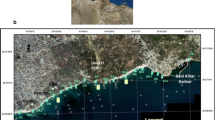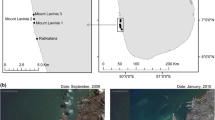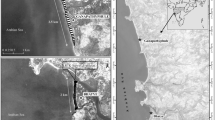Abstract
Soil erosion in the coastal area (coastal erosion) is often a crucial issue in geotechnical aspects mainly with regards to the sediment transport phenomena accompanied by turbulent characteristics of breaking sea waves. This study takes into account a stretch of 1 km of coastline along Veerampattinam coastal stretch essentially to examine the erosion and accretion characteristics which would further lead to the estimation of sediment budgeting for the study area. A study of coastal wave dynamics was performed to understand the seasonal variations of the wave characteristics. The changes in the coastal morphology of the area have been studied periodically using a GPS device and this quantifies the volumetric changes in the beach morphology. The net sediment transport rate and also the quantity of the suspended sediments in motion is also estimated. The experimental results which suggest accretion along the southern part of the Veerampattinam breakwater and thereby erosion along the northern part are quite coherent with the practical observations. The study reveals that in the north-easterly monsoon and post-monsoon seasons, the zone of study experiences rampant erosion with around 20,000 m3 of coastal sediment deposition. The study reveals that the phenomena of coastal erosion in the study area can be addressed by a sediment transfer amounting 24,436 m3 of beach sand from the south side to the northern side of the breakwater.
Access provided by Autonomous University of Puebla. Download conference paper PDF
Similar content being viewed by others
Keywords
- Sediment transport rate
- Suspended sediments
- Wave-climate study
- Coastal erosion
- Accretion
- Artificial beach nourishment
1 Introduction
Located along the Coromandel Coast, between latitudes 11°45’N and 12°03’N and longitudes 79°37’E and 79°53’E, Pondicherry has been a world-renowned tourist attraction since ages. The virgin beaches of this international city were renowned to be extraordinarily spectacular by the tourists. But since recent past, this tourism legacy is turning into a nightmare with the beaches getting crippled with a multitude of changes. Contamination, erosion, seawater intrusion and a countless number of other issues are arising day by day. This could prove to be a blot on the rich tourism legacy of the town. A lot of man-made intervention and natural phenomena are posing a great threat to this urban agglomeration. With the needs rising for a commercial harbor in the town, the harm to nature is in contrast with the so-called urban development.
Though a harsh coastal wave climate prevails only for less than a week in Puducherry (Upon observation of historic wave climate data), the effect of coastal erosion in the city is felt across a stretch of 6 km. Things worsened after a fishing harbor and its breakwaters were constructed at Thengaithittu, at the southern part of the city. Thereafter, the coastal erosion along the northern part of the city aggravated drastically. As an interim remedy, the government of Puducherry has constructed seawalls using massive boulders and plain cement concrete tetrapods to absorb the energy of the breaking waves. Coastal engineers are assigned a mammoth task of combating coastal erosion.
2 Need for Study
As a result of the construction of structures like groynes and breakwaters, the entire coastline particularly the beaches experience severe erosion and constant shorelines changes, the outcomes being drastic. The northern part of the coastline is experiencing erosion, whereas the southern part is either stable or undergoing accretion. The beaches, the lifeline of the town are slowly losing their pristine identity. In addition, there is supposed to be a remarkable tidal wave variation which is greatly impacting the fishermen folk. The beach land is getting engulfed by the sea water which is replacing the shoreline of Puducherry. The town is facing a reduction in the tourist economy. Every year a large amount of land area is being occupied by the sea. Various natural and man-made activities are primarily responsible for an unstable coastal zone. Longshore sediment transport, controlled mainly by nearshore topography and wave characteristics is an important factor which governs beach erosion. Waves generated deep in the ocean propagate to the nearshore and dissipate their energy on the coast leading to the sediments being lifted which further generate longshore currents and result in littoral sediment transport.
3 Wave Climate Measurement
There exists a wide variety of instruments for wave measurements, some of which are placed either at or below the sea-level. There exist some field instruments too to measure wave height and wave directions. The use of such instruments depend upon the required accuracy, repeatability and range of instrumentation needed. The prevailing environmental conditions are also crucial in deciding the choice of instrumentation. Previous works by Chen et al. [1] and (Katz) suggest some of the available instrumentation methods for coastal wave climate measurement. For the current study, online surf data from NIOT [2] and Magicseaweed [3] were collected periodically which claim that the data were procured from buoys installed in the nearshore environment of Pondicherry.
4 Definition of Wave Parameters
The actual processing of wave information is involved in the determination of wave statistics. The goal is producing a statistical estimate from the analyzed time series data to describe an irregular sea state in simple parametric form. The characteristic height H and characteristic period T are the two most important parameters necessary for adequately quantifying a given sea state. Other derived parameters from H and T may also be put to use in the parametric representation of the irregular seas. The definition of characteristic height includes the mean height and the root-mean-square height. Of these, the most commonly used height is the significant height which is quite similar to the visual height estimated by an experienced observer [4].
4.1 Significant Wave Height
Hs (or H1/3), the significant wave height is the most important quantity to describe the state of a sea. Previous work by Sverdrup and Munk [5] gives an introduction to the concept of the significant wave height. The simplest method of calculating the significant wave height is by observing and ranking the waves in a wave record and then choosing the highest one-third waves. The average of the chosen wave gives the significant wave height as follows
5 Profile Calculation
The focus of our study was a kilometer long stretch of beach starting from the southern limb of the Veerampattinam breakwater southwards to Veerampattinam fishermen bay (see Fig. 1). The initial point chosen was chosen as the western face of the first visible column of the southern breakwater. The final point was at an offset of 64 m from the central column of the fishermen bay on the Veerampattinam coast. The stretch of around 1 km was further divided into intervals of 200 m. The Line of Sight was established by using a Vernier theodolite.
The study of the profile was continued across the three monsoon seasons namely pre-monsoon, post- monsoon and non-monsoon barring the months of November and December 2015 due to incessant rains in the region. The observation of the profile was done every fortnight when the tidal conditions were normal. After the line of sight was traced out, the profile observation was carried out with GARMIN E-TREX (see Fig. 2) G.P.S by procuring the Northing, Easting and Elevation details at fixed points.
Along the 1 km stretch, offsets at intervals of 5 m each were marked at every 200 m toward the sea till the point wetted by the sea water. The G.P.S was employed to obtain the coordinates and elevation at the offsets. The difference between the G.P.S elevations between corresponding fortnights gives an idea of the morphological changes of the beach profile. With the changes in beach profile obtained across the various weeks, the volumetric changes in the beach profile could be obtained and this could be later used for calculating the sediment budgeting which is defined as the accounting of sources, sinks and redistribution pathways of sediments in a unit region over unit time [6].
Figures 3, 4, 5 and 6 above show the variation in beach morphology in longitudinal and transverse directions across various months corresponding to Monsoon and Post-Monsoon seasons.
6 Measurement of Sediment Transport Rate
Tracers are one of the means of obtaining alongshore sediment transport rate, but the process gets difficult in practice as in most cases they (tracers) get buried or lost in transit. Another possible means to arrive at the sediment transport rate is from the measured volume of deposited sand. But this process also lacks practical feasibility. For the current study, a set-up was made to collect suspended sediments and sand samples which are presented in the following clauses.
6.1 Sediment Samples Collecting System
As the area of study was a stretch of only a kilometer, the scope of sand trap [7] (an indigenously developed tool for trapping suspended sediments) was undermined and the collection of sediment samples were performed manually with sampling bottles and the number of suspended sand particles per m3 of water sample were found out.
6.2 Collection of Sand Samples
The sand sediments are collected from the study area at every 200 m intervals. The sand sampling is done at both the intermediate zone and the splash zone. In the situation of lack of sand trap, the collection done is manual assuring that only top layer sand up to a depth of 1 mm only was obtained. After obtaining the sand samples, they were subjected to sieve analysis to obtain the predominant particle size at each zone. This could give a rough idea of the predominant size of the particles in motion in both intermediate and splash zones. The collected sand was carefully preserved in sealed sampling bags, and later subjected to laboratory sieve analysis for obtaining the predominant particle size. The predominant particle size is obtained by computing D10, D30 and D60 values from the semi-log plot of sieve analysis.
7 Calculation of Wave Parameters, Potential Sediment Transport Rate and Profile Volume
The wave parameters such as wave height and direction are referred from on-line wave surf data Magicseaweed [3], NIOT [2] and calculations are made.
The longshore sediment transport takes place by beach drifting and transport in the breaker zone. The longshore sediment transport rate may be computed by employing energy flux methods which relate sediment transport with wave-generated momentum or energy gradient. CERC method as used by Vijayakumar et al. [8] was found suitable for this study area. The CERC method for bulk sediment transport rate is expressed in Eq. 2.
where Hsb is the near shore-breaking wave height, αb is the breaker angle. It can be seen that Qth is a function of ‘H’ and α only.
The elevation of total profile near the shoreline and just above shoreline is taken using GPS for the entire stretch. The elevations of various grids are known and its area is calculated using Simpson formula (Eq. 3) [9] and thereafter volume of the sections are calculated (Eq. 4) as follows
where e1, e2… = elevation of the sections; D = interval between elevations
where A1, A2 = area of the section.
8 Results
The result obtained from the calculation of the net sediment transport at Veerampattinam coastal stretch can be highlighted as follows:
-
During the month of July–September, i.e. south-westerly Monsoon, the net sediment movement is southerly and hence most of the sediments get trapped on the up-drift side of the breakwater field which results in the formation of beach till the mouth of the breakwater. The net drift is 5126.87 m3/day which is towards South. For this season, the predominant particle size in the intermediate zone was 0.177 mm and that in the Splash zone was 0.157 mm. The amount of suspended sediments obtained in this season is 3.0139 kg/m3.
-
During the month of October-December i.e. north-easterly Monsoon, the sediment movement is northerly and the net drift is 3417.72 m3/day North direction. For this season, the predominant particle size in the intermediate zone was 0.1446 mm and that in the Splash zone was 0.0948 mm. The amount of suspended sediments obtained in this season is 1.86 kg/m3.
-
During the month of January-March, i.e. non monsoon or post-monsoon period the sediment movement is predominantly northerly and the net drift is 3139.71 m3/day North direction. For this season, the predominant particle size in the intermediate zone was 0.1304 mm and that in the Splash zone was 0.108 mm. The amount of suspended sediments obtained in this season is 2.4786 kg/m3.
-
It was observed from the volumetric profile calculation that there was a significant difference between the beach profiles for various monsoon seasons. There was significant growth in the volume of the beach during the north-westerly and Non-Monsoon season, thereby indicating accretion in the southern zone and erosion in the Northern zone.
The results so obtained are summarized in the following tables (Tables 1 and 2)
9 Conclusion
From the results the following conclusion can be drawn:
-
Construction of breakwater field at the Veerampattinam region has created an imbalance situation in the coastal stretch of about 1 km.
-
Since the predominant movement of sediment is northerly, there is a predominant accretion in the southern region and pronounced erosion in the northern zone
-
According to the volumetric calculations performed, a sediment transfer amounting 24,436 m3 of beach sand from south side to the northern side has to be performed.
-
Sediment by-passing (a technique of transferring the excessive accreted sand from the accreting zone to the eroding zone) is the best alternative than the conventional hard solutions as this turns to be a more feasible one.
-
If this situation continues, the entire coastal stretch with natural beaches will be destroyed and it will lead to a threat to biodiversity.
References
Chen G-Y, Chien H-C (2008) Measuring progressive edge wave by a single instrument: applications in tsunami and typhoon waves. In: 2008 Taiwan-polish joint seminar on coastal protection, pp. A37-A48
NIOT (2015–2016, July-March) Ocean observation systems. Retrieved from National Institute of Ocean Technology: https://www.niot.res.in/index.php/node/index/128/
Magicseaweed (2015–2016, July-March) Wave buoys and weather stations. Retrieved from magicseaweed.com: https://magicseaweed.com/Sri-Lanka-Wave-Buoys/54/?wave=true&wind=true&ll=7.74%2C80.69&zoom=7
Kinsman B (1965) Wind waves. In: Kinsman B (eds) The Generation and propagation on the ocean surface. Prentice Hall Incorporated
Sverdrup H, Munk W (1974) Wind, sea and swell: theory of relations for forecasting. Hydrographic Office Publications, U.S department of Navy, p 44
Slaymaker O (2003) The sediment budget as conceptual framework and management tool: the interactions between sediments and water (Guest Editor: Brian Kronvang). Hydrobiologia, pp 1–3
Verhoeven R, Huygens M, Poucke LV, Witter J, Hakvoort H (1996) Design of a smart sand trap construction as a part of an interregional environmental study. Trans Eng Sci
Vijayakumar G, Rajasekaran C, Sundararajan T, Govindarajulu D (2014) Studies on the dynamic response of coatsal sediments due to natural and manmade activities for the Puducherry coast. Indian J Mar Sci
Cook M, Rimmer (1993) Maths Xtra. Stafford College, Stafford, katz, I. (n.d.). Ocean wave measurements. APL technical Digest
Author information
Authors and Affiliations
Corresponding author
Editor information
Editors and Affiliations
Rights and permissions
Copyright information
© 2022 Springer Nature Singapore Pte Ltd.
About this paper
Cite this paper
Sabah, N., Sil, A., Vijayakumar, G. (2022). A Season-Wise Geotechnical and Morphological Study of Alteration in Coastal Profile Along the Shores of Puducherry, India. In: Dey, A.K., Mandal, J.J., Manna, B. (eds) Proceedings of the 7th Indian Young Geotechnical Engineers Conference. IYGEC 2019. Lecture Notes in Civil Engineering, vol 195. Springer, Singapore. https://doi.org/10.1007/978-981-16-6456-4_46
Download citation
DOI: https://doi.org/10.1007/978-981-16-6456-4_46
Published:
Publisher Name: Springer, Singapore
Print ISBN: 978-981-16-6455-7
Online ISBN: 978-981-16-6456-4
eBook Packages: EngineeringEngineering (R0)










